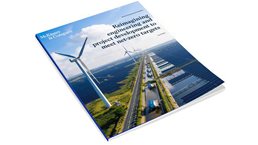As the global transition to net-zero emissions gains momentum, the infrastructure sector will experience large changes, ranging from the buildout of renewable-power capacity and electricity grids to the decarbonization of existing assets around the world. Recent McKinsey research shows that, in a scenario where the world achieves net-zero emissions in 2050, organizations would need to pour $3.5 trillion more into low-emissions capital stock annually than they do today.1 At the same time, some existing high-emissions infrastructure and equipment would need to be decommissioned or would be underutilized. The convergence of these trends would result in a transformation of the world’s built environment. Here is a look at what changes might lie ahead and what they could mean for infrastructure investors and owners worldwide.
An economy-wide transformation
To stabilize the climate and limit rising physical risks from hazards such as extreme heat and more frequent storms, science tells us that it is necessary to stop increasing the concentration of greenhouse gases (GHGs) in the atmosphere—that is, to reduce net GHG emissions to zero. Since substantial GHG emissions now come from each of seven energy and land-use systems, every system would need to greatly reduce its emissions for this net-zero goal to be reached (Exhibit 1). Power and industry, two asset-heavy systems, together generate about 60 percent of global CO2 emissions. Across all seven systems, the combustion of fossil fuels—coal, gas, and oil—accounts for more than 80 percent of CO2 emissions, based on current accounting methodologies.

Thus, the transition to net-zero emissions would entail shifts in the production of many goods and services that underpin these energy and land-use systems. For example, under the Net Zero 2050 scenario from the Network for Greening the Financial System (NGFS), our analysis suggests that oil and gas production volumes would be 55 percent and 70 percent lower, respectively, by 2050 than they are today. Low-emissions steel, which makes up about one-quarter of today’s output, would account for almost all of the world’s steel production by 2050 (Exhibit 2). Production of electric power in 2050 would be more than double what it is today as other sectors use more electricity and developing countries add generation capacity to meet their populations’ energy needs (Exhibit 3). Other industries, such as those that manage carbon with carbon capture and storage (CCS) technologies, could also grow.


To achieve the production shifts envisioned under the NGFS Net Zero 2050 scenario, organizations would retire or transform some existing physical assets and acquire new ones. McKinsey analysis suggests that about $275 trillion in cumulative spending on physical assets, or approximately $9.2 trillion per year, would be needed between 2021 and 2050 across the sectors that we studied. This total includes $3.5 trillion more spending on physical assets than today, and the additional amount would all go into low-emissions assets (Exhibit 4). Moreover, about $1 trillion of the capital that is now being spent on high-emissions assets, such as coal-fired power plants, would be reallocated to low-emissions assets. (When we account for increases in spending that are expected to take place as incomes and populations grow, as well as for currently legislated transition policies, we find that the required increase in spending would be lower, though still about $1 trillion.)

Overall, spending would undergo a profound shift: 65 percent of today’s spending on physical assets for energy and land-use systems goes toward high-emissions assets, but over the next 30 years, an average of 70 percent of spending would be on low-emissions assets.
Would you like to learn more about our Global Infrastructure Initiative?
The outlook for sectors
Sectors are unevenly exposed in the net-zero transition. The sectors with the highest degree of exposure directly emit large quantities of greenhouse gases (for example, the coal and gas power sector) or sell products that emit greenhouse gases (such as the fossil-fuel sector or the automotive sector). Approximately 20 percent of global GDP is in these sectors (Exhibit 5). Another 10 percent of GDP is in sectors with high-emissions supply chains, such as construction. Here, we focus on three sectors—power, industry, and buildings—in which infrastructure and industrial assets will likely be affected by the net-zero transition, as our analysis of the NGFS Net Zero 2050 scenario suggests.

Power
To decarbonize and meet growing demand for electricity, the global power sector would need to phase out fossil fuel–based generation and add capacity for low-emissions power. These changes would require substantial annual capital spending from 2021 to 2050, estimated at an annual average of $1 trillion for power generation, $820 billion for power grids, and $120 billion for energy storage (Exhibit 6). The possibility of asset stranding, which could be significant in the power sector, has prompted concerns about financial-sector risk and the need to build capabilities for quantifying and managing it. Our analysis suggests that about $2.1 trillion of the sector’s coal and gas power capital stock could be stranded by 2050 in the NGFS Net Zero 2050 scenario. Eighty percent of this amount is today’s capacity.

Industry
Two heavy industrial sectors—steel and cement—together account for approximately 14 percent of global CO2 emissions and 47 percent of the industry sector’s CO2 emissions. While technologies are still emerging, steel and cement production can broadly be decarbonized in three ways: by installing CCS equipment at existing plants, by shifting to low-emissions fuel and other inputs, or by building new low-emissions production capacity. These approaches would require additional capital spending (Exhibit 7). This capital spending would, in turn, lift unit production costs, which will be a key challenge for steel and cement producers. By 2050, the average cost to produce a metric ton of steel would be 30 percent higher than it is today; for cement, the comparable increase would be 45 percent in the scenario modeled here.

Buildings
In the NGFS Net Zero 2050 scenario, the buildings sector would decarbonize by improving energy efficiency—for example, through the use of insulation—and by replacing fossil fuel–powered heating and cooking equipment with low-emissions systems (Exhibit 8). The average annual spending on physical assets between 2020 and 2050 would be $1.7 trillion per year. The buildings sector’s biggest adjustments during this transition would be managing the up-front capital costs for end consumers to retrofit equipment and aligning incentives among various stakeholders (such as building owners who invest capital and tenants who may see the benefits of reduced operating costs).


Voices on Infrastructure: Reimagining engineering and project development to meet net-zero targets
Managing the transition
The transition to net-zero emissions would require economies and societies to make major adjustments.2 Infrastructure investors and owners can work with governments, businesses, and enabling institutions to support many of these adjustments through coordinated action, undertaken over extended planning and investment horizons. Three categories of action stand out. First, in the financial realm, institutions can catalyze capital reallocation by developing new financing structures, financial instruments, and markets; arranging collaborations across the public and private sectors; and managing risk to stranded assets. Second, organizations in the infrastructure value chain can manage demand shifts and cost increases by building awareness of climate risks and opportunities, lowering technology costs, nurturing industrial ecosystems, collaborating across value chains, and creating incentives for goods producers. Finally, infrastructure organizations in the private sector can help address socioeconomic impacts such as job losses, reskilling, and redeployment programs for affected workers, while governments might consider economic diversification programs, social support schemes, and other compensating mechanisms.
Working toward net-zero emissions will be a far-reaching global endeavor, and the infrastructure sector will have an integral role to play in transforming the world’s capital stock. Although capital spending during the transition will be substantial, it is important not to view this spending only as a cost. Much of it could yield operating-cost savings through reduced fuel consumption, improved material and energy efficiency, and lower maintenance expenses. What’s more, many investments would position organizations to tap into growing demand for low-emissions goods and services. For infrastructure owners and investors, the time is now to begin pursuing the opportunities that the net-zero transition will bring.
This article is part of Global Infrastructure Initiative’s Voices on Infrastructure.
This article is adapted from The net-zero transition: What it would cost, what it could bring, a McKinsey Global Institute report by Annabel Farr, Danielle Imperato, Mekala Krishnan, Tomas Nauclér, Daniel Pacthod, Dickon Pinner, Hamid Samandari, Sven Smit, Humayun Tai, Lola Woetzel, and Weige Wu. To obtain the report, visit www.mckinsey.com/net-zero.

